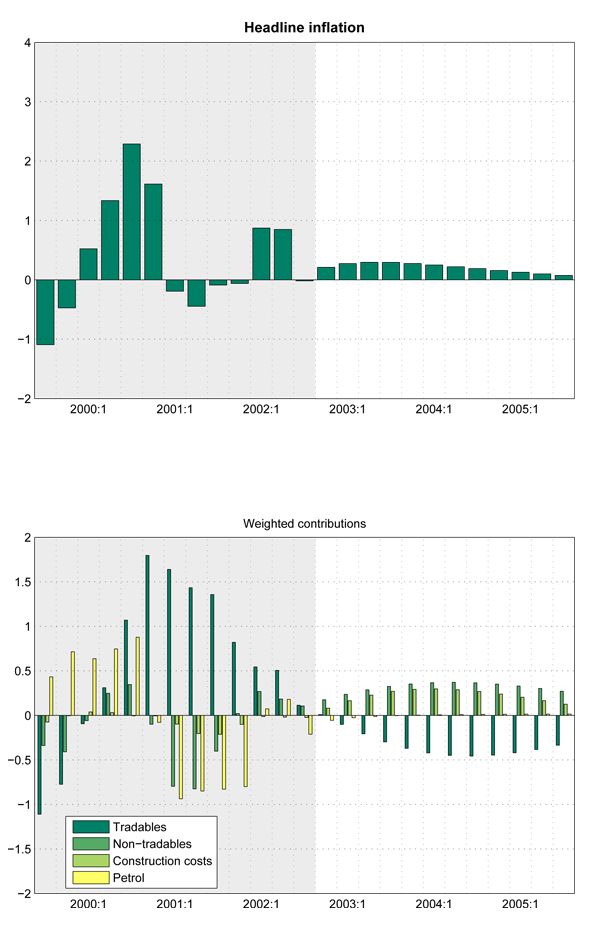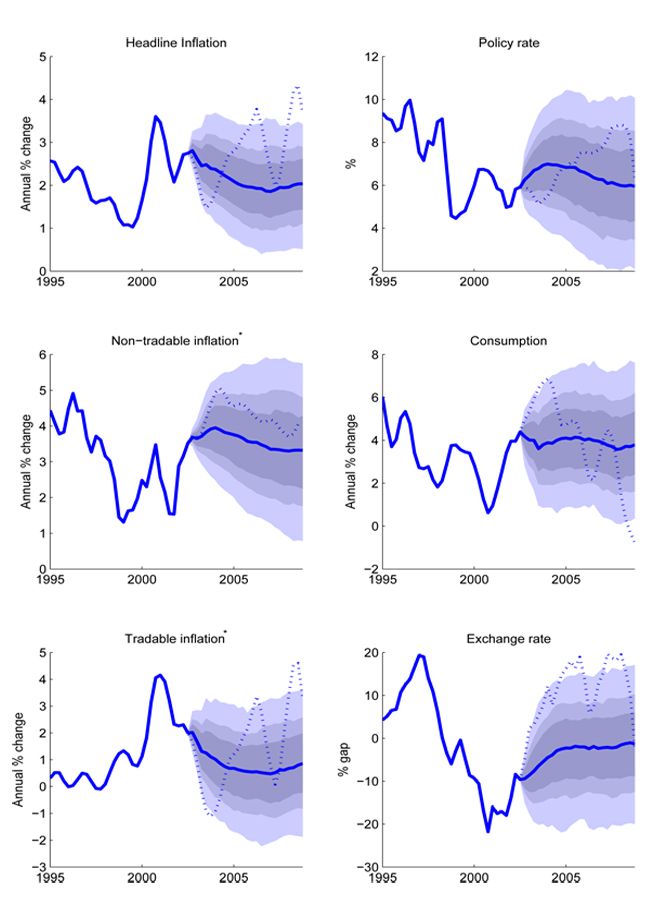Macroeconomic Modeling and Inflation-Rate Forecasting at the Reserve Bank of New Zealand
By Jaromir Benes, International Monetary Fund
The primary function of the Reserve Bank of New Zealand (RBNZ) is to formulate and implement monetary policy to maintain price stability. To fulfill its legislative mandate, the RBNZ is committed to keeping the inflation rate within 1 and 3 percent, as set out in the Policy Targets Agreement between the Governor and the Minister of Finance. This means that the RBNZ must periodically adjust the Official Cash Rate (OCR), which influences the price of borrowing money in New Zealand. Many economic factors affect inflation, and it often takes a long time for a change to the OCR to affect the economy. For this reason, the RBNZ, like central banks around the world, must base monetary policy decisions on projections about the future state of the economy—in particular, about inflation and the factors contributing to it.
To make these projections the RBNZ use the Kiwi Inflation Targeting Technology (KITT) macroeconomic model. The KITT model was developed by a team of RBNZ staff, including myself. Based on MATLAB®, KITT not only facilitates inflation forecasting; it also tells a detailed economic story that helps the RBNZ explain its projections to the public and other stakeholders. KITT builds in more technical rigor than its predecessor, the Forecast and Policy System (FPS), by matching its underlying mathematical and economic structure to the actual equations implemented in the code.
Choosing a Development Environment
We chose MATLAB for this work for several reasons. First, using MATLAB enabled the RBNZ to take advantage of the IRIS Toolbox, a free MATLAB based package for advanced dynamic stochastic general equilibrium (DSGE) modeling that I developed when I was a macroeconomic researcher at RBNZ. IRIS is also used by other central banks and policy-making institutions around the world.
Second, MATLAB enabled us to complete our entire workflow—from data import through simulation to reporting and publishing—in a single environment. Third, because MATLAB is so widely used by economists, researchers, and students, we could share our code with, and learn from, other central banks and economics institutions.
All data analysis and modeling for forecasting and policy at the RBNZ is done in MATLAB. Other groups within the RBNZ—including the Monetary Policy Committee—use MATLAB generated output to further analyze the results produced by the model, investigate correlations within the data, and present the results to others.
Using the KITT Model for Macroeconomic Forecasting
A principal advantage of KITT is that it enables us to use macroeconomic data to estimate the model parameters. (A typical parameter would be the household’s propensity to consume.) In FPS, these parameters were chosen by the modeler. In KITT, they are estimated based on more than 15 years' worth of data on the New Zealand economy incorporating 27 different time series, including housing investment, oil prices, wages, and construction costs, as well as foreign output, interest rates, and the exchange rate.
Because of its complexity, only approximate numerical techniques can be used to solve, simulate, and estimate KITT. First, we use the Optimization Toolbox™ fsolve function to find the model’s steady-state equilibrium (the economic conditions that would prevail in the model economy in the long run, assuming the absence of shocks). Then, we use the qz and ordqz functions to compute approximate dynamic equilibria (conditions in which no agent has an incentive to change its behavior around the steady state).
To estimate the model parameters, we evaluate how well the model matches the observed data for many different parameter sets and use statistical methods to infer which are the optimal ones. We run the Optimization Toolbox fmincon function to maximize an objective function combining information derived from the data with our assumptions about the most appropriate parameter values. Some concepts used by the model, such as potential output or nontradable consumption, cannot be directly observed. We identify the most likely paths for these unobserved concepts by running a Kalman filter. The MATLAB interface to the LAPACK and BLAS libraries make it easy to run fast repeated evaluations of the Kalman filter.
Once the parameters have been estimated, we use MATLAB to simulate the model and produce a no-judgment forecast (Figure 1). This is an initial run of the model in which households, firms, banks, and other agents are represented as systems of equations with multiple unknowns. We can then use MATLAB to plot fan charts that characterize the degree of uncertainty around our nojudgment forecasts. Each fan chart is essentially a probability distribution about future economic events (Figure 2).
The no-judgment forecast serves as a baseline economic projection. Judgmentally adjusted, or conditional, forecasts provide additional insights. In these forecasts we introduce shocks to the model based on the judgment of policy experts and analysts. Shocks enable us to incorporate extra information into the forecast rather than relying solely on model simulations. The New Zealand Emissions Trading Scheme, which introduces a price on greenhouse gases, is an example of a shock occurring at a future date but likely to have an inflationary effect today. We can run a conditional forecast that incorporates this shock to project the effect it would have on inflation.
A Shared Framework Founded on Economic Theory
Using MATLAB and the IRIS toolbox to build the KITT model has helped the RBNZ bring more technical rigor to our macroeconomic forecasting. For example, by defining the various agents in the economy and applying optimization techniques, we derive optimal behaviors for those agents mathematically, given the particular objectives and constraints attributed to the agent. One of the most important equations in the model is the Phillips curve, which shows the relation between inflation and unemployment. In our previous model we did not formally link the underlying economic theory to our reduced-form specification of the Phillips curve. In our MATLAB based model we directly connect the theory to the equations and then to the Phillips curve itself.
As we continue to enhance the KITT model for short and medium-term forecasting and analysis we are using MATLAB to develop and run additional mediumterm structural models and other statistical model-based analysis. With all RBNZ models now implemented in MATLAB, the RBNZ has a common platform for evaluating the economy and making informed decisions.
Kiwi Inflation Targeting Technology (KITT)
KITT is a Dynamic Stochastic General Equilibrium (DSGE) model in which agents such as firms in various sectors and the central bank interact with each other according to well-defined assumptions (for example, the assumption that firms seek to maximize profit). The model is stochastic because it can describe how shocks (a term used in economics for unexpected or random events) ripple through the economy, and it is dynamic because it explicitly predicts how today’s events and decisions affect what happens tomorrow.
Published 2010 - 91844v00

